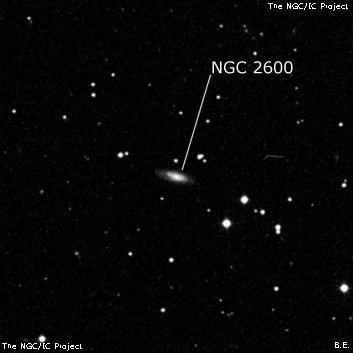NGC/IC Project Restoration Effort
(This is a very very beta version)
NGC2600


Basic Information
Location and Magnitude
Right Ascension: 8:34:44.8
Declination: +52:42:55
Constellation: UMA
Visual Magnitude: 14.2
Historic Information
Discoverer: Bigourdan
Year of discovery: 1886
Discovery aperture: 12.4
Observational
Summary description: No description
Sub-type: Sb
Corwin's Notes
=====
NGC 2600, 2602, 2603, 2605, and 2606. There is a group of six galaxies here.
Two (N2602 and N2606) of the three brightest were seen twice by JH, while he
curiously missed the brightest, N2600 (LdR and Bigourdan picked this up). Of
the three others seen by LdR, JH and Dreyer gave new GC and NGC numbers to
only two, the other being taken as a star once, and being thought as one of
the other two "novae" the second time.
[There is also some confusion in LdR's 1861 PT paper, noted by JH in the GC
Notes and by Dreyer in LdR's 1880 monograph, with NGC 2599 (= h507) 30 degrees
south. Both JH and Dreyer come to the correct conclusion that this is a
simple transcription error and that the correct numbers are h508 (= N2602) and
h510 (= N2606).]
JH's observations are relatively clear, though he does note a 10 second RA
discrepancy between his first and second observations of N2602 (the second is
more nearly correct). Also, his note "... np a star (about [PA =] 5 deg np)"
should read "sp" instead of "np". As I've noted, his observations point at
the second and third brightest in the group as being the two that he found.
The first time LdR went over the group, he found three nebulae:
1850, Feb. 9. A fine object, 3 neb., one (N2600) B, another (N2606)
f[ollowing] pB and E, the third (N2602) north and the last degree of
faintness. [Dreyer appends the note about N2599.]
LdR's second observation turned up four nebulae, and he provided a sketch:
1858, Mar. 11. 4 neb. found, alpha (N2603) is F, S, bM; beta (N2605) is
vvF, gamma (N2602) F, S, lbM; delta is E and has a Nucl, a F * sf. alpha
and gamma are about 5 arcmin dist. from one another, and beta and delta
about the same dist. apart.
Interestingly, he includes the faintest galaxy in the group in the sketch, but
has it drawn as a star.
Finally, a third observation yeilded only two nebulae:
1867, Mar. 5. 2 neb. seen nearly pf, p one (the unnumbered faintest galaxy
in the group) eeF, f one (N2606) eF. Measures extremely difficult. Pos. 92
deg (2). Dist. 118 arcsec (1).
In each case, the noted relative brightnesses and positions very clearly
identify the objects that LdR and his observers are seeing. I find it
informative that he turned up a different set of objects each night, pointing
most likely to the importance of seeing, transparency, observer skill and
fatigue, mirror reflectivity, and a host of other variables that determine the
eventual outcome of any given observation.
When Bigourdan went over the field, he found only the brightest three
galaxies, N2600, N2602, and N2606, noting the others as simply "Non vue" (not
seen).
Making sense out of all of this is fairly straight-forward (though I swapped
NGC 2602 and NGC 2605 in my first pass a few years ago; apologies to all). We
simply adopt the NGC numbers for JH's two objects as given by Dreyer. JH's
positions are not bad, either, though both he and Dreyer used a mean of the
two discordant RAs for N2602. NGC 2600 is easy as its relatively good
position comes from Bigourdan, and his comment about the two stars preceding
is accurate.
This leaves NGC 2603 and NGC 2605 to distribute among the three "novae" found
by LdR. I've arbitrarily assigned these to the fourth and fifth brightest
galaxies in the group (LdR's alpha and beta), leaving only the sixth and
faintest without an NGC number. I've included this in the position table as
"N2606 w comp". The final entry in the table, "N2606 e comp" is the "F * sf"
that LdR notes in his 1858 observation. On the DSS, this looks like a close
double, or perhaps another companion galaxy.
Steve's Notes
=====
NGC 2600
18" (3/13/10): first in a group of 5 NGC galaxies. At 280x appeared very faint, small, elongated 2:1 E-W, 30"x15", low even surface brightness. Located 2' ENE of a 50" pair of mag 12 stars. First in a group with NGC 2602, NGC 2603, NGC 2605, NNGC 2606 and second brightest (next to NGC 2606, which is located 8.6' NE).
17.5" (3/25/95): faint, small, elongated 3:2 E-W, 25"x15". Brightens slightly to a near stellar nucleus. Forms the vertex of a thin isosceles triangle with two mag 12 stars 2' SW. Also forms an equilateral triangle with two mag 14 stars closer to the north. Located 8.6' WSW of NGC 2606. In a trio with NGC 2602 7.5' NE.



